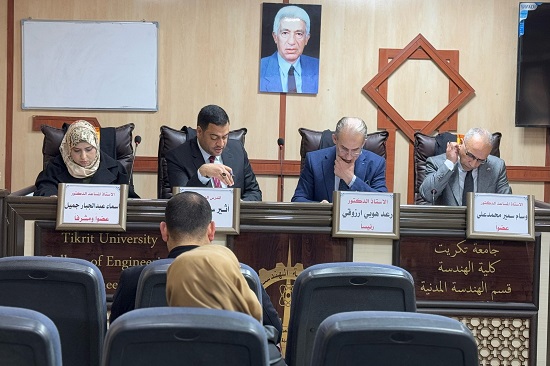| News Details |
Participation in a scientific discussion committee at Tikrit University
2025-03-11

The Head of the Natural Resources Development Department at the Upper Euphrates Center for Sustainable Development Research at the University of Anbar (Assistant Professor Dr. Atheer Salim Obaid), participated in a public scientific discussion committee for the master’s thesis at the College of Engineering / University of Tikrit for the student (Zainab Thaer Dawood), for her thesis tagged: (Establishing Intensity – Duration – Frequency Curves for Salah Al Deen Governorate, Iraq).On Monday, 3/3/2025, in the discussion hall of the Department of Civil Engineering at the College of Engineering / University of Tikrit.
The summary of the student's study in her thesis revealed that the intensity of rainfall can be considered an important factor in the design and operation of hydraulic installations, as the intensity, duration and frequency curves (IDF) are very important for planning, managing, operating and designing all water resources projects. The study focused on drawing these curves for Salah al-Din Governorate, based on the data of the ground stations from Tikrit, Tuz, Baiji and Samarra, reinforced by the proposed stations derived from website data using the satellite (GS_MAP GC). The analysis used maximum daily rainfall data from 1990 to 2022, where the lost rainfall data was supplemented using the Forecast Maximization Algorithm (EM) using the Statistical Software (SPSS).
To ensure homogeneity between the data, a specialized curve analysis was relied upon, and the optimal number of stations was determined to be seven, which necessitates the proposal of three additional stations, satellite data for the period 2000-2022 were statistically corrected using the Radial Neural Network (RBF) method. Data consistency was verified by the double mass curve technique, while homogeneity was assessed using the P ettite test. All the necessary statistical variables were calculated, and the results showed high accuracy, as all statistical measures approached the optimal values.
The discussion committee consisted of:
1- Prof. Raad Hobi Arzouki / Chairman
2- Assoc. Prof. Wissam Samir Muhammad Ali / Member
3- Dr. Atheer Salim Obaid / Member
4- Assoc. Prof. Asma’a Abdul-Jabbar Jameel / Member and supervisor
After the extensive discussion by the discussion committee, and the student's defense of her thesis. The thesis was accepted. We wish the student and the discussion committee all the best and success.
#Upper_Euphrates_Center_for_Sustainable_Development_Research








